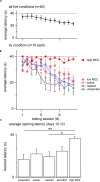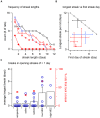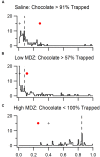Anxiolytic Treatment Impairs Helping Behavior in Rats
- PMID: 27375528
- PMCID: PMC4896909
- DOI: 10.3389/fpsyg.2016.00850
Anxiolytic Treatment Impairs Helping Behavior in Rats
Abstract
Despite decades of research with humans, the biological mechanisms that motivate an individual to help others remain poorly understood. In order to investigate the roots of pro-sociality in mammals, we established the helping behavior test, a paradigm in which rats are faced with a conspecific trapped in a restrainer that can only be opened from the outside. Over the course of repeated test sessions, rats exposed to a trapped cagemate learn to open the door to the restrainer, thereby helping the trapped rat to escape (Ben-Ami Bartal et al., 2011). The discovery of this natural behavior provides a unique opportunity to probe the motivation of rodent helping behavior, leading to a deeper understanding of biological influences on human pro-sociality. To determine if an affective response motivates door-opening, rats receiving midazolam, a benzodiazepine anxiolytic, were tested in the helping behavior test. Midazolam-treated rats showed less helping behavior than saline-treated rats or rats receiving no injection. Yet, midazolam-treated rats opened a restrainer containing chocolate, highlighting the socially specific effects of the anxiolytic. To determine if midazolam interferes with helping through a sympatholytic effect, the peripherally restricted beta-adrenergic receptor antagonist nadolol was administered; nadolol did not interfere with helping. The corticosterone response of rats exposed to a trapped cagemate was measured and compared to the rats' subsequent helping behavior. Rats with the greatest corticosterone responses showed the least helping behavior and those with the smallest responses showed the most consistent helping at the shortest latency. These results are discussed in terms of their implications for the interaction between stress and pro-social behavior. Finally, we observed that door-opening appeared to be reinforcing. A novel analytical tool was designed to interrogate the pattern of door-opening for signs that a rat's behavior on one session influenced his behavior on the next session. Results suggest that helping a trapped rat has a greater motivational value than does chocolate. In sum, this series of experiments clearly demonstrates the fundamental role of affect in motivating pro-social behavior in rodents and the need for a helper to resonate with the affect of a victim.
Keywords: altruism; emotional contagion; empathy; helping; midazolam; rodent.
Figures







Similar articles
-
Anxiolytic treatment of a trapped rat reduces helping and anxiogenic treatment increases helping: Evidence for emotional contagion in altruism.Pharmacol Biochem Behav. 2024 Nov;244:173846. doi: 10.1016/j.pbb.2024.173846. Epub 2024 Aug 8. Pharmacol Biochem Behav. 2024. PMID: 39127241
-
Female rats release a trapped cagemate following shaping of the door opening response: Opening latency when the restrainer was baited with food, was empty, or contained a cagemate.PLoS One. 2019 Oct 1;14(10):e0223039. doi: 10.1371/journal.pone.0223039. eCollection 2019. PLoS One. 2019. PMID: 31574116 Free PMC article.
-
Helping behavior in rats (Rattus norvegicus) when an escape alternative is present.J Comp Psychol. 2019 Nov;133(4):452-462. doi: 10.1037/com0000178. Epub 2019 Mar 21. J Comp Psychol. 2019. PMID: 30896232
-
Lessons from helping behavior in rats.Curr Opin Neurobiol. 2021 Jun;68:52-56. doi: 10.1016/j.conb.2021.01.001. Epub 2021 Jan 23. Curr Opin Neurobiol. 2021. PMID: 33498010 Review.
-
The complex affective and cognitive capacities of rats.Science. 2024 Sep 20;385(6715):1298-1305. doi: 10.1126/science.adq6217. Epub 2024 Sep 19. Science. 2024. PMID: 39298607 Review.
Cited by
-
Beware of Strangers: Dogs' Empathetic Response to Unknown Humans.Animals (Basel). 2024 Jul 22;14(14):2130. doi: 10.3390/ani14142130. Animals (Basel). 2024. PMID: 39061592 Free PMC article.
-
Effects of heroin on rat prosocial behavior.Addict Biol. 2019 Jul;24(4):676-684. doi: 10.1111/adb.12633. Epub 2018 May 4. Addict Biol. 2019. PMID: 29726093 Free PMC article.
-
Neural basis of prosocial behavior.Trends Neurosci. 2022 Oct;45(10):749-762. doi: 10.1016/j.tins.2022.06.008. Epub 2022 Jul 16. Trends Neurosci. 2022. PMID: 35853793 Free PMC article. Review.
-
Robotic animals as new tools in rodent neuroscience research: proposed applications of zooinspired robots for mouse behavioral testing.Front Behav Neurosci. 2025 Feb 24;19:1545352. doi: 10.3389/fnbeh.2025.1545352. eCollection 2025. Front Behav Neurosci. 2025. PMID: 40066371 Free PMC article.
-
Empathy for Pain: Insula Inactivation and Systemic Treatment With Midazolam Reverses the Hyperalgesia Induced by Cohabitation With a Pair in Chronic Pain Condition.Front Behav Neurosci. 2018 Nov 16;12:278. doi: 10.3389/fnbeh.2018.00278. eCollection 2018. Front Behav Neurosci. 2018. PMID: 30519165 Free PMC article.
References
LinkOut - more resources
Full Text Sources
Other Literature Sources

